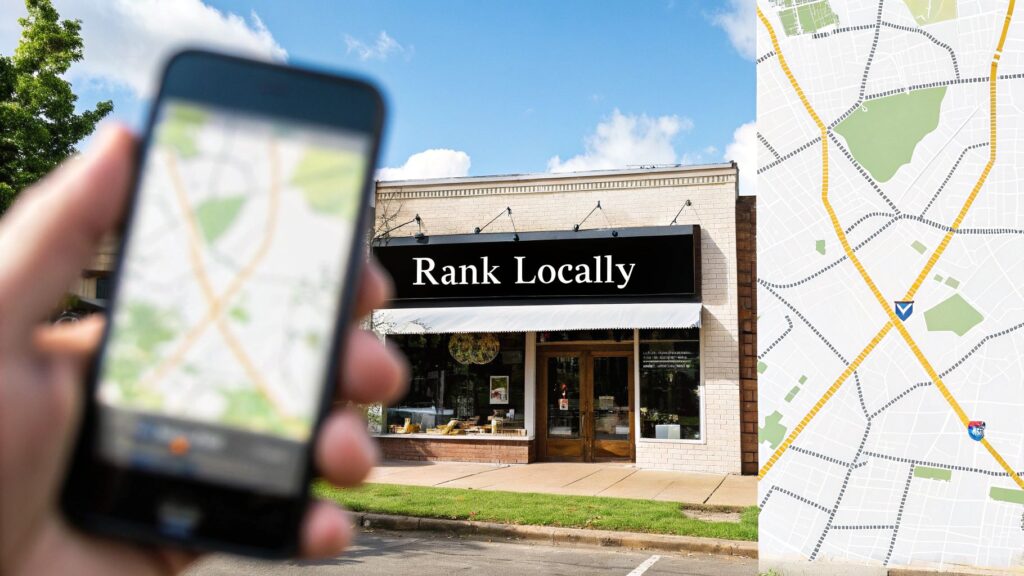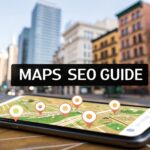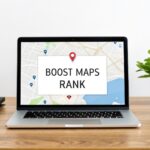You can be the best arborist in the state, but if your phone isn't ringing, it doesn't matter. When a massive branch is hanging over someone's house after a storm, they aren't flipping through a phone book. They're grabbing their phone and searching for 'emergency tree removal near me.'
If you're not showing up at that exact moment, you're invisible. That's what local SEO for tree service is all about—being the first and best answer when potential customers in your area need you right now.
Why Your Tree Service Needs Local SEO
Relying on word-of-mouth and a truck magnet just isn't enough anymore. The way people find local services has completely changed. When a homeowner needs help, their first move is a Google search. The tree care companies at the top of Google Maps and search results are the ones getting all the calls.
This isn't some complex marketing fluff. It's about being there in the moments that count. Showing up online is what separates a packed schedule from a crew sitting around waiting for work.
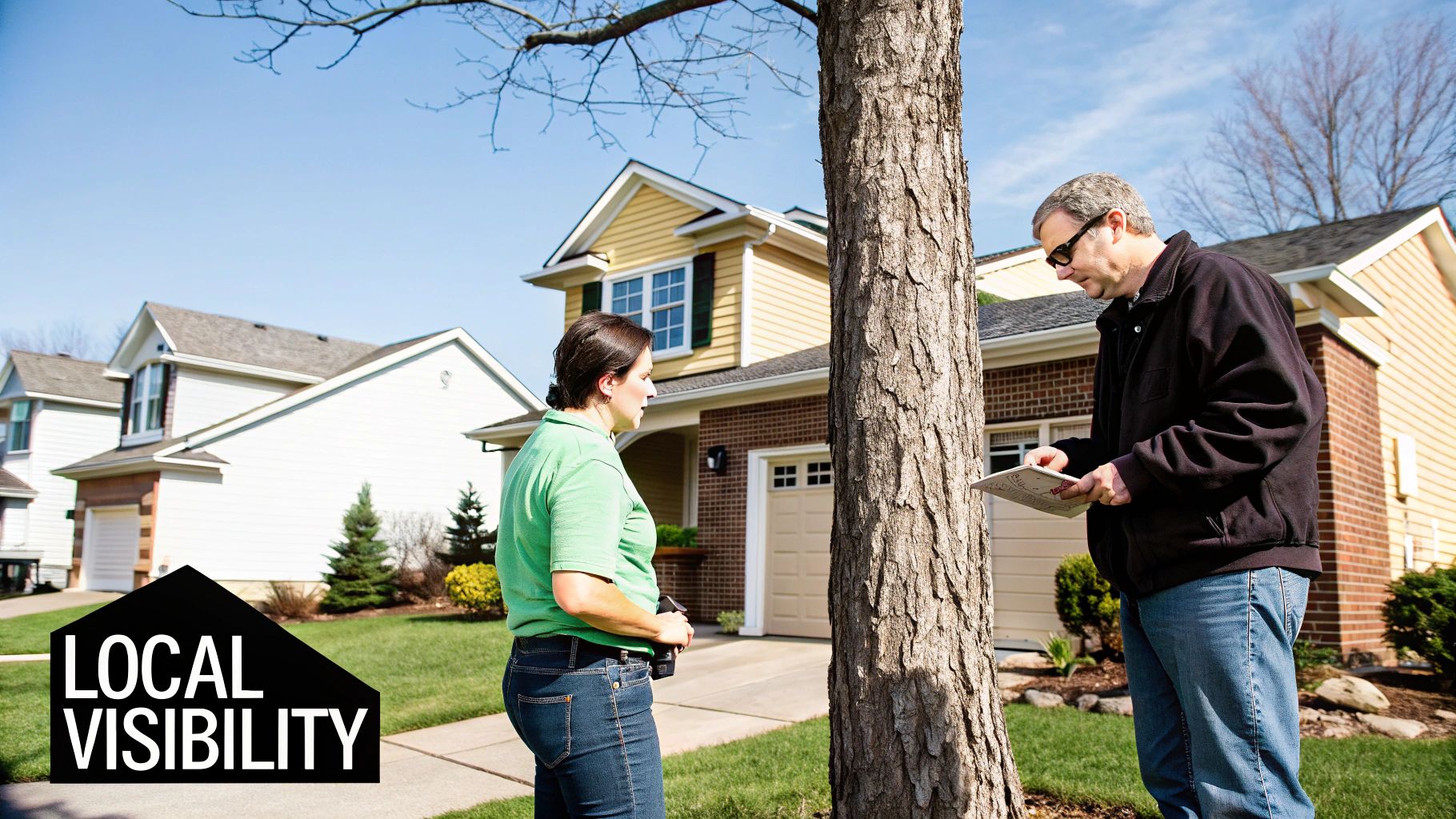
Connecting With Modern Customers
Think about it—your ideal customers are already looking for you online. A smart local SEO plan just makes sure it's your business they find, not the other guys. It’s all about showing up where it matters most:
- Google Maps: This is huge. When someone pulls up Google Maps and searches for "tree trimming," that little box showing the top three local companies (the "map pack") is pure gold. You need to be in it.
- Organic Search Results: Ranking on the first page for keywords like "stump grinding in [Your City]" brings people who are ready to hire directly to your website.
- Voice Search: People are constantly asking Siri or Alexa to "find an arborist nearby." Those devices pull answers from well-optimized local business profiles.
In Short: Local SEO positions your company as the easy, trustworthy, and obvious choice for people in your service area who have a problem that needs solving.
Capturing a Growing Market
The demand for professional tree care isn't slowing down. In fact, the global market is expected to hit USD 1.49 billion in 2025, a jump from USD 1.3 billion in 2024. More homeowners, more development, and a bigger focus on property safety mean more business for arborists.
With nearly all of these new customers starting their search online, a solid local SEO presence is your ticket to grabbing a bigger piece of that pie.
To get a clearer picture of how these pieces fit together, it's worth understanding the core elements of a winning local marketing strategy. This is the foundation for building a system that consistently brings in high-quality leads.
Optimizing Your Google Business Profile
Think of your Google Business Profile (GBP) as your digital storefront. It’s what pops up in that Google Maps "local pack" when a homeowner down the street searches for "tree service near me." It's often the very first impression you'll make, so you've got to make it a good one.
Getting this right is more than just claiming your profile. A properly tuned-up GBP is one of the most powerful tools you have for local SEO for tree service. It's basically a mini-website right on the search results page, giving people everything they need to call you instead of the other guy.
Nailing the Foundational Details
First things first, let's get the basics absolutely perfect. If your info is wrong or incomplete, it’s a huge red flag for both Google and your customers. Consistency across the web is the name of the game.
Your Name, Address, and Phone number (NAP) needs to be identical everywhere—on your GBP, your website, and your Yelp page. Even a tiny difference like "St." on one and "Street" on another can cause issues.
- Business Name: Use your actual business name. Don't stuff it with keywords like "Best Tree Service in Austin." That’s a fast track to getting your profile suspended.
- Address: If you have a physical office, list it. If you are a service-area business, you can hide your address and set a service area instead. This tells Google which towns and neighborhoods you cover.
- Phone Number: Use a local number with your area code. It helps reinforce that you're a legitimate local business.
If you’re just getting started, this initial setup is non-negotiable. For a detailed walkthrough, check out this guide on How to Set Up Your Google Business Profile to make sure you don't miss a thing.
Choosing the Right Business Categories
This is where many tree service owners drop the ball. Your primary category tells Google the main thing you do. Be specific.
- Primary Category: For most, "Tree service" is the right choice.
- Secondary Categories: Here's where you can really set yourself apart. Add every other relevant service you offer. Think "Arborist," "Landscaper," or "Stump Removal Service."
Adding those extra categories lets you show up for a much wider variety of searches.
Writing a Compelling Business Description
You get 750 characters for your business description—make them count. This is your chance to tell people who you are and why you’re the best choice.
Try to work in your main keywords and service areas naturally. Instead of a bland "We offer tree services," try something like, "Your trusted, insured tree service for safe tree removal and stump grinding in Springfield and Clark County." It’s more descriptive, builds trust, and hits those local keywords.
This infographic lays out the whole process perfectly.
As you can see, a complete profile is a mix of good information, great photos, and consistent activity. All these pieces work together to push you higher in the local rankings.
Showcase Your Work with Photos and Services
In the tree care business, seeing is believing. A GBP profile loaded with high-quality photos builds instant credibility and trust. A picture of a clean job site says a lot.
Here’s a simple photo strategy:
- Before-and-After Shots: These are pure gold. Show a hazardous, overgrown tree and then the clean, safe yard after you're done.
- Team in Action: Snap pictures of your crew safely operating equipment. It shows professionalism and a commitment to safety.
- Your Equipment: A clean truck and a well-maintained grinder tell people you’re a serious operation.
In Short: Before you upload your photos, geotag them. This embeds location data into the image file, which is another powerful signal to Google about where you do business.
The "Services" section is another gem that most businesses ignore. Don't just list "Tree Removal." Break it down into all the specific things you do:
- Emergency Storm Damage Cleanup
- Stump Grinding
- Tree Pruning & Trimming
- Cabling and Bracing
- Land Clearing
Putting prices on standard services can make you stand out. A top-notch GBP is the heart of a solid Local Maps SEO strategy.
Use Google Posts to Stay Active
Google Posts are like mini-ads that show up right on your profile. They’re a fantastic way to keep your GBP looking fresh.
You can use them to highlight:
- Recent Jobs: Post a great photo from a finished job.
- Special Offers: Running a "10% off stump grinding" special? Post it.
- Seasonal Tips: Share a quick tip about getting trees ready for winter.
Posts expire after seven days, so making a new one every week is a great habit. It tells Google your business is active, which is a positive ranking signal.
Building Trust with Online Reviews
When it comes to tree care, trust is everything. Homeowners are inviting you onto their property to do serious work. Your online reputation, built on customer reviews, tells them you're the right crew for the job.
Great reviews don't just feel good; they directly fuel your local SEO for tree service. They're powerful social proof, signaling to both Google and potential customers that you're a high-quality operation. A steady flow of positive feedback is one of the fastest ways to climb the rankings in the Google Maps pack.
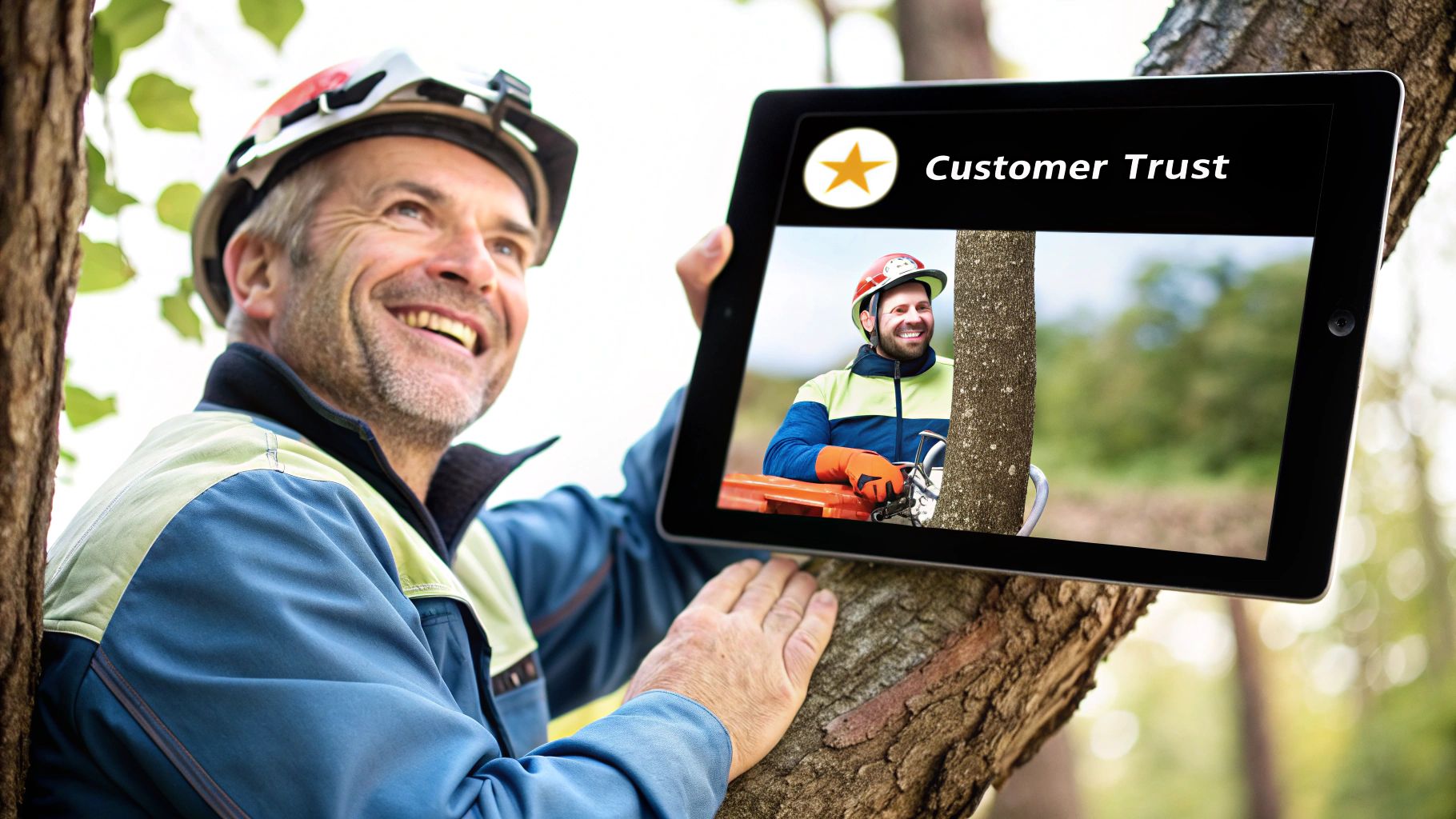
Recent surveys show that 85% of consumers trust online reviews for local businesses just as much as a personal recommendation. Even more telling? A staggering 99% read reviews before picking a service provider. Managing your reputation isn't just a marketing task—it's a core part of your business strategy. You can dig deeper into how customers perceive tree service reviews online to see just how critical this is.
Making It Easy for Happy Customers to Leave Feedback
Here’s a secret: most happy customers are willing to leave you a review. The catch? They're busy. You have to make the process simple. The best time to ask is right after the job is done and the yard is clean.
Here are a few simple ways to get it done:
- A Simple Text or Email: Send a follow-up message with a direct link to your Google review page. Something like, "Hey [Customer Name], thanks for your business today! If you were happy with our work, we'd be grateful for a quick review at this link."
- QR Codes on Invoices: Add a QR code to your invoices that goes straight to your review page.
- A "Review Us" Page on Your Site: Create one central page on your website with links to your profiles on Google, Angi, and Yelp.
The goal is to eliminate any guesswork. Give them a one-click path to share their positive experience.
How to Handle Every Single Review
Getting reviews is only half the battle. Responding to them—all of them—is what really separates the pros from the amateurs. It shows you're paying attention and you care about what customers think.
Responding to good reviews is easy. A quick "Thank you" makes your happy customer feel appreciated. But how you handle the negative ones is where you can truly shine.
In Short: A professional, calm, and helpful response to a bad review can actually win you more business than a dozen five-star ratings. It proves you have integrity.
Turning a Negative Review into a Positive Outcome
It’s going to happen. No matter how perfect your work is, a negative review will eventually pop up. Don't panic. And don't get into a public argument. Instead, use a simple formula to put out the fire.
A Simple Plan for Responding to Bad Reviews:
- Acknowledge their feeling. Start with, "We're sorry to hear your experience wasn't what you expected."
- Take ownership. Show you're taking it seriously. "Our team strives for 100% satisfaction, and we're disappointed we fell short here."
- Take it offline. This is the most important step. Give them a direct line to a real person. "I want to understand more and make this right. Please call me directly at [Your Number]. – [Your Name]"
This approach shows everyone watching that you're a proactive professional who solves problems.
Getting Your Website Content Right for Local Customers
Your website has two customers to please: the homeowner with a tree problem and the Google algorithm. To win at local search, your content has to speak to both of them. It needs to be clear about what you do while also signaling to Google that you're the top tree pro in town.
A well-built website is a trust-builder. It instantly shows you're a serious, professional operation.
Build Out Your Core Service Pages
Think of your website like a physical store. Each distinct service you offer—from tree removal to stump grinding—deserves its own dedicated page.
This strategy is fundamental for local SEO for tree service. When someone in your town searches for "tree trimming," Google is looking for the single best, most specific page about tree trimming.
Get started by creating individual pages for your main services:
- Tree Removal: Detail your process, safety protocols, and the kinds of trees you remove.
- Stump Grinding: Explain the benefits and the equipment you use.
- Tree Pruning and Trimming: Show off your expertise. Talk about tree health and seasonal trimming.
- Emergency Tree Service: Have a page dedicated to your 24/7 storm damage and emergency response.
- Disease Diagnosis & Treatment: Position yourself as a true arborist. Talk about common local tree diseases.
Don't forget to sprinkle in photos of your crew doing this work on each page. Visual proof is powerful.
Own Your Service Area with Location Pages
This is the secret sauce most tree companies miss. Just listing the towns you serve on your contact page isn't enough. To show up in search results for a specific city, you have to prove to Google you actually belong there.
The most effective way is by creating location-specific service pages.
Instead of just one "Tree Removal" page, create targeted pages like:
- Tree Removal in Springfield
- Tree Removal in Dayton
- Stump Grinding in Beavercreek
The key here is that each page has to be unique. You can't just copy and paste the same text and swap out the city name. On your "Springfield" page, talk about a big oak tree you removed near a local park or mention a common issue with trees in that area. This tells search engines and real people that you genuinely work in and understand their community.
In Short: Weave in local context. A line like, "We've helped dozens of homeowners in the Oakwood historic district safely remove storm-damaged maples," is a thousand times more powerful than generic fluff.
Answer Customer Questions with a Simple Blog
A blog isn't just for fancy tech companies; for a local tree service, it's an SEO goldmine. Your potential customers are full of questions, and a blog is the perfect place to answer them.
Every blog post is another chance to rank on Google. You'll attract people who aren't quite ready to call for a quote but are doing their initial research.
What should I write about?
- Cost Questions: "How Much Does Stump Grinding Cost in Ohio?"
- Problem-Solving Guides: "5 Signs Your Ash Tree Is in Trouble"
- Seasonal Advice: "How to Prep Your Trees for a Winter Storm"
- Safety Topics: "Why DIY Tree Removal Is a Terrible Idea"
Each post frames you as a helpful authority. This content-first approach is a pillar of any solid tree removal contractors marketing plan because it builds a steady pipeline of customers.
People Also Ask About Local Content
Here are a few common questions about creating content for your local market.
How do I add local keywords without it sounding robotic?
Write for humans first. Instead of awkwardly stuffing "tree service Springfield" into every sentence, work it in naturally. Talk about specific neighborhoods, mention local landmarks, or reference the types of trees common to your region.
How often do I need to be blogging?
Consistency beats frequency. It’s better to publish one or two genuinely helpful posts per month than to crank out four mediocre ones. A steady drumbeat of fresh content signals to Google that your site is active.
Is website content really more important than my customer reviews?
They're a tag team. Great content gets you found on Google. Great reviews convince that person to pick up the phone. You need a strong website to attract traffic and a stellar reputation to turn that traffic into jobs.
Getting the On-Page SEO Right for Your Website
Let's cover the more "technical" side of local SEO for tree service. You don't need to be a web developer to make a massive difference here. These next few moves are all about sending clear local signals to Google, right from your own website.
Your website’s content tells potential customers what you do, but these on-page signals tell Google where you do it. Nailing this is how you start showing up in those all-important map results.
So, What's Local Business Schema Markup?
"Schema markup" sounds complicated, but it's just a special bit of code you add to your website. It translates your key business info into a language Google understands perfectly.
This code clearly points out your:
- Business Name
- Address
- Phone Number
- Hours of Operation
- Services Offered (e.g., tree removal, stump grinding)
When you spoon-feed Google this information, you make its job easy. In return, Google is more likely to feature your business in rich search results, like the map pack. Properly implemented schema can give a 30% bump in visibility for local searches.
Building Your Local Citations (Your Digital Footprint)
Next up are citations. A local citation is any mention of your business's Name, Address, and Phone number (NAP) online. Think of places like Yelp, Angi, and other online directories.
Every time your business is listed with consistent information on a reputable site, it’s another trusted voice telling Google, "Yep, this company is legit and located right where they say they are."
In Short: Consistency is everything. If your business name is "Joe's Tree Service LLC" on one site and "Joe's Tree Service" on another, it creates confusion for search engines. It has to be identical everywhere.
Start by making sure you're listed correctly on the big-name platforms:
- Yelp
- Angi
- Thumback
- Better Business Bureau (BBB)
Once those are locked in, you can branch out to more industry-specific directories. It might feel tedious, but building these citations pays off with long-term ranking stability. For a look at how this fits into the bigger picture, check out our guide on local SEO services for small business.
People Also Ask About On-Page SEO
Here are a few common questions about the technical side of local SEO.
What is a NAP and why is it so important for SEO?
NAP stands for Name, Address, and Phone number. It’s your business’s digital fingerprint. When your NAP is identical across your website, Google Business Profile, and all online directories, it proves to Google that your information is accurate and trustworthy. This is a huge factor in local search rankings.
How do you handle local SEO for multiple locations?
If you have more than one office, each location needs its own dedicated page on your website. Each of these pages must feature the unique NAP and operating hours for that specific branch, along with content that speaks directly to that service area. You'll also need a separate, verified Google Business Profile for each physical location.
How can I check my local citations?
You can manually search your business name on sites like Yelp and Yellow Pages. For a more efficient approach, online tools like Moz Local or BrightLocal can run a full audit. They'll show you where you're listed, flag any inconsistencies, and point you toward new directories.
Got Questions About Tree Service SEO? Let's Talk.
Even with the best plan, you're going to have questions. Here are the most common questions I get from tree care pros. My goal is to give you straight answers so you can keep moving forward.
How Long Until My Phone Starts Ringing from SEO?
This is always the first question. The honest answer? It’s a marathon, not a sprint.
You can see some quick wins, sometimes in just a few weeks, especially after you optimize your Google Business Profile. But for stable, top-of-the-page rankings for big money keywords like "tree removal," you're realistically looking at a 3 to 6-month timeframe.
Why the range?
- Your Local Competition: Ranking in a big city is a different ballgame than a smaller town.
- Your Starting Point: A brand-new website with zero reviews has a steeper hill to climb.
- Your Consistency: SEO isn't a one-time task. The businesses that win are the ones consistently adding content and earning reviews month after month.
The key is to focus on steady progress. The reward is a pipeline of leads that you don't have to keep paying for through ads.
Do I Really Need a Blog for My Tree Service Website?
Yes. A thousand times, yes. A blog is one of the most powerful—and overlooked—tools in your marketing toolbox. It’s what transforms you from just another company into the go-to tree expert in your area.
For every one person searching "tree service near me," there are ten more asking Google questions like:
- "What are the signs of a dying oak tree?"
- "How much does stump grinding cost?"
- "Can I trim a tree that's touching power lines?"
Every time you write a blog post answering one of those questions, you create a new doorway for a potential customer to find you. You’re meeting them early, building trust, and signaling to Google that your site is a hub of valuable information.
What’s More Important: My Website or My Google Business Profile?
That’s like asking what’s more important, your chainsaw or your wood chipper. You need both to get the job done right. They’re a team.
Your Google Business Profile (GBP) is your frontline. It's what gets you into the Google Maps pack and it's often the very first thing a potential customer sees. Your GBP is all about immediate visibility and quick actions—getting that phone call.
Your website is your headquarters. It's where you build real authority, show off your best work, and provide the in-depth info that convinces someone you're the right pro for the job.
In Short: A great GBP drives the traffic. A great website closes the deal. You can't dominate your local market without both firing on all cylinders.
Ready to stop waiting for the phone to ring and start getting a predictable stream of high-quality leads? At Clicks Geek, we specialize in building local SEO strategies that put tree service companies at the top of Google. Schedule your free strategy session with us today and let's talk about growing your business.
Is Your Business Ranking in Google Maps?
Turn Google Maps into a Lead Engine w/ Clicks Geek’s AI-powered local SEO. 3,000+ clients served. Our proprietary, fully done-for-you Maps SEO system handles everything—keyword targeting, local optimization, content, reviews, and ranking strategy—automatically.


